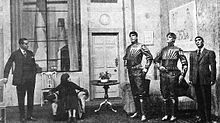Early robots

In 1928, one of the first humanoid robots, Eric, was exhibited at the annual exhibition of the Model Engineers Society in London, where it delivered a speech. Invented by W. H. Richards, the robot's frame consisted of an aluminium body of armour with eleven electromagnets and one motor powered by a twelve-volt power source. The robot could move its hands and head and could be controlled through remote control or voice control.[50] Both Eric and his "brother" George toured the world.[51]
Westinghouse Electric Corporation built Televox in 1926; it was a cardboard cutout connected to various devices which users could turn on and off. In 1939, the humanoid robot known as Elektro was debuted at the 1939 New York World's Fair.[52][53] Seven feet tall (2.1 m) and weighing 265 pounds (120.2 kg), it could walk by voice command, speak about 700 words (using a 78-rpm record player), smoke cigarettes, blow up balloons, and move its head and arms. The body consisted of a steel gear, cam and motor skeleton covered by an aluminum skin. In 1928, Japan's first robot, Gakutensoku, was designed and constructed by biologist Makoto Nishimura.
The German V-1 flying bomb was equipped with systems for automatic guidance and range control, flying on a predetermined course (which could include a 90-degree turn) and entering a terminal dive after a predetermined distance. It was reported as being a 'robot' in contemporary descriptions [54]
Modern autonomous robots
The first electronic autonomous robots with complex behaviour were created by William Grey Walter of the Burden Neurological Institute at Bristol, England in 1948 and 1949. He wanted to prove that rich connections between a small number of brain cells could give rise to very complex behaviors – essentially that the secret of how the brain worked lay in how it was wired up. His first robots, named Elmer and Elsie, were constructed between 1948 and 1949 and were often described as tortoises due to their shape and slow rate of movement. The three-wheeled tortoise robots were capable of phototaxis, by which they could find their way to a recharging station when they ran low on battery power.
Walter stressed the importance of using purely analogue electronics to simulate brain processes at a time when his contemporaries such as Alan Turing and John von Neumann were all turning towards a view of mental processes in terms of digital computation. His work inspired subsequent generations of robotics researchers such as Rodney Brooks, Hans Moravec and Mark Tilden. Modern incarnations of Walter's turtles may be found in the form of BEAM robotics.[55]

The first digitally operated and programmable robot was invented by George Devol in 1954 and was ultimately called the Unimate. This ultimately laid the foundations of the modern robotics industry.[56] Devol sold the first Unimate to General Motors in 1960, and it was installed in 1961 in a plant in Trenton, New Jersey to lift hot pieces of metal from a die casting machine and stack them.[57] Devol's patent for the first digitally operated programmable robotic arm represents the foundation of the modern robotics industry.[58]
The first palletizing robot was introduced in 1963 by the Fuji Yusoki Kogyo Company.[59] In 1973, a robot with six electromechanically driven axes was patented[60][61][62] by KUKA robotics in Germany, and the programmable universal manipulation arm was invented by Victor Scheinman in 1976, and the design was sold to Unimation.
Commercial and industrial robots are now in widespread use performing jobs more cheaply or with greater accuracy and reliability than humans. They are also employed for jobs which are too dirty, dangerous or dull to be suitable for humans. Robots are widely used in manufacturing, assembly and packing, transport, earth and space exploration, surgery, weaponry, laboratory research, and mass production of consumer and industrial goods.[63]
Future development and trends
| External videos | |
|---|---|
Various techniques have emerged to develop the science of robotics and robots. One method is evolutionary robotics, in which a number of differing robots are submitted to tests. Those which perform best are used as a model to create a subsequent "generation" of robots. Another method is developmental robotics, which tracks changes and development within a single robot in the areas of problem-solving and other functions. Another new type of robot is just recently introduced which acts both as a smartphone and robot and is named RoboHon.[64]
As robots become more advanced, eventually there may be a standard computer operating system designed mainly for robots. Robot Operating System (ROS) is an open-source software set of programs being developed at Stanford University, the Massachusetts Institute of Technology, and the Technical University of Munich, Germany, among others. ROS provides ways to program a robot's navigation and limbs regardless of the specific hardware involved. It also provides high-level commands for items like image recognition and even opening doors. When ROS boots up on a robot's computer, it would obtain data on attributes such as the length and movement of robots' limbs. It would relay this data to higher-level algorithms. Microsoft is also developing a "Windows for robots" system with its Robotics Developer Studio, which has been available since 2007.[65]
Japan hopes to have full-scale commercialization of service robots by 2025. Much technological research in Japan is led by Japanese government agencies, particularly the Trade Ministry.[66]
Many future applications of robotics seem obvious to people, even though they are well beyond the capabilities of robots available at the time of the prediction.[67][68] As early as 1982 people were confident that someday robots would:[69] 1. Clean parts by removing molding flash 2. Spray paint automobiles with absolutely no human presence 3. Pack things in boxes—for example, orient and nest chocolate candies in candy boxes 4. Make electrical cable harness 5. Load trucks with boxes—a packing problem 6. Handle soft goods, such as garments and shoes 7. Shear sheep 8. prosthesis 9. Cook fast food and work in other service industries 10. Household robot.
Generally such predictions are overly optimistic in timescale.
New functionalities and prototypes
This section needs to be updated. (August 2021) |
In 2008, Caterpillar Inc. developed a dump truck which can drive itself without any human operator.[70] Many analysts believe that self-driving trucks may eventually revolutionize logistics.[71] By 2014, Caterpillar had a self-driving dump truck which is expected to greatly change the process of mining. In 2015, these Caterpillar trucks were actively used in mining operations in Australia by the mining company Rio Tinto Coal Australia.[72][73][74][75] Some analysts believe that within the next few decades, most trucks will be self-driving.[76]
A literate or 'reading robot' named Marge has intelligence that comes from software. She can read newspapers, find and correct misspelled words, learn about banks like Barclays, and understand that some restaurants are better places to eat than others.[77]
Baxter is a new robot introduced in 2012 which learns by guidance. A worker could teach Baxter how to perform a task by moving its hands in the desired motion and having Baxter memorize them. Extra dials, buttons, and controls are available on Baxter's arm for more precision and features. Any regular worker could program Baxter and it only takes a matter of minutes, unlike usual industrial robots that take extensive programs and coding to be used. This means Baxter needs no programming to operate. No software engineers are needed. This also means Baxter can be taught to perform multiple, more complicated tasks. Sawyer was added in 2015 for smaller, more precise tasks.[78]
Prototype cooking robots have been developed and could be programmed for autonomous, dynamic and adjustable preparation of discrete meals.[79][80]
Etymology

The word robot was introduced to the public by the Czech interwar writer Karel Čapek in his play R.U.R. (Rossum's Universal Robots), published in 1920.[6] The play begins in a factory that uses a chemical substitute for protoplasm to manufacture living, simplified people called robots. The play does not focus in detail on the technology behind the creation of these living creatures, but in their appearance they prefigure modern ideas of androids, creatures who can be mistaken for humans. These mass-produced workers are depicted as efficient but emotionless, incapable of original thinking and indifferent to self-preservation. At issue is whether the robots are being exploited and the consequences of human dependence upon commodified labor (especially after a number of specially-formulated robots achieve self-awareness and incite robots all around the world to rise up against the humans).
Karel Čapek himself did not coin the word. He wrote a short letter in reference to an etymology in the Oxford English Dictionary in which he named his brother, the painter and writer Josef Čapek, as its actual originator.[6]
In an article in the Czech journal Lidové noviny in 1933, he explained that he had originally wanted to call the creatures laboři ("workers", from Latin labor). However, he did not like the word, and sought advice from his brother Josef, who suggested "roboti". The word robota means literally "corvée", "serf labor", and figuratively "drudgery" or "hard work" in Czech and also (more general) "work", "labor" in many Slavic languages (e.g.: Bulgarian, Russian, Serbian, Slovak, Polish, Macedonian, Ukrainian, archaic Czech, as well as robot in Hungarian). Traditionally the robota (Hungarian robot) was the work period a serf (corvée) had to give for his lord, typically 6 months of the year. The origin of the word is the Old Church Slavonic rabota "servitude" ("work" in contemporary Bulgarian, Macedonian and Russian), which in turn comes from the Proto-Indo-European root *orbh-. Robot is cognate with the German root Arbeit (work).[81][82]
English pronunciation of the word has evolved relatively quickly since its introduction. In the U.S. during the late 1930s to early 1940s the second syllable was pronounced with a long "O" like "row-boat."[83][better source needed] By the late 1950s to early 1960s, some were pronouncing it with a short "U" like "row-but" while others used a softer "O" like "row-bought."[84] By the 1970s, its current pronunciation "row-bot" had become predominant.
The word robotics, used to describe this field of study,[4] was coined by the science fiction writer Isaac Asimov. Asimov created the "Three Laws of Robotics" which are a recurring theme in his books. These have since been used by many others to define laws used in fiction. (The three laws are pure fiction, and no technology yet created has the ability to understand or follow them, and in fact most robots serve military purposes, which run quite contrary to the first law and often the third law. "People think about Asimov's laws, but they were set up to point out how a simple ethical system doesn't work. If you read the short stories, every single one is about a failure, and they are totally impractical," said Dr. Joanna Bryson of the University of Bath.[85])



No comments:
Post a Comment